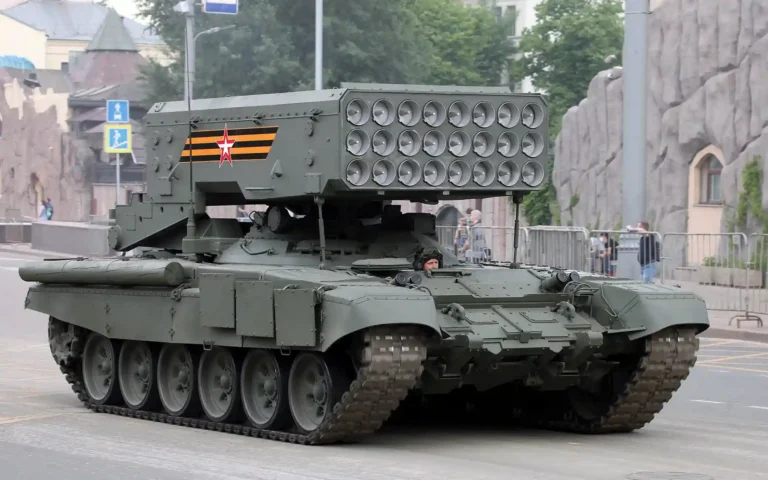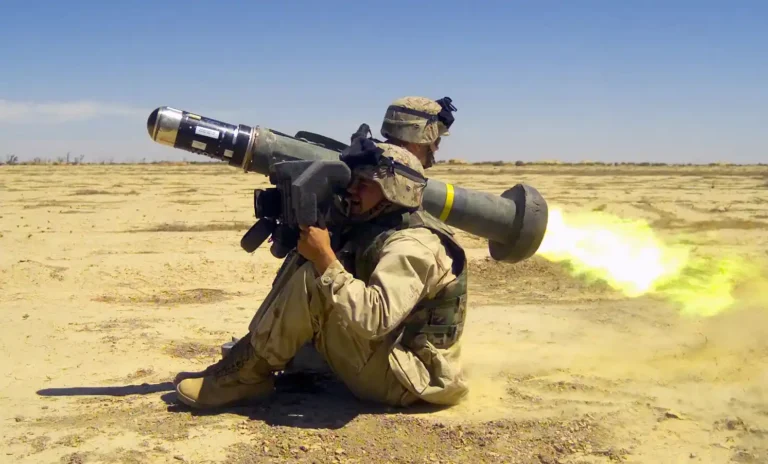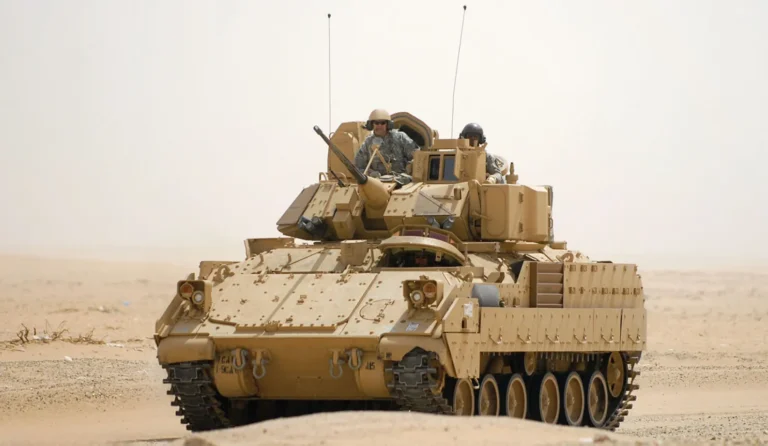Follow Us:
Share
Table of Contents:
The Russian T-90 Tank is a third-generation main battle tank that developed as an evolution of the T-72, and intended to replace it in active service eventually.
This formidable vehicle has a 125 mm 2A46 smoothbore main gun, supported by the advanced 1A45T fire-control system.
Additionally, it boasts a modernized engine and a thermal sight for the gunner, ensuring superior targeting and operational effectiveness.
To enhance its defensive capabilities, the T 90 Tank integrates a comprehensive range of protective features. Its armor consists of steel and composite materials, bolstered by Kontakt-5 explosive reactive armor (ERA), which improves resistance against anti-tank threats.

The tank is also equipped with smoke grenade dischargers and the sophisticated Shtora system, designed to jam incoming anti-tank guided missiles (ATGMs) through infrared interference.
The Russian T-90 Tank was conceived and manufactured by Uralvagonzavod, a renowned defense contractor based in Nizhny Tagil, Russia. Officially inducted into the Russian military in 1992, the Russian T-90 Tank remains a cornerstone of modern armored warfare for Russia and various other countries around the world.
The Russian T-90 Tank Development
The development of the Russian T-90 Tank traces its roots back to a Soviet-era initiative aimed at creating a successor to the T-64, T-72, and T-80 main battle tanks (MBTs). Among the options, the T-72 platform was selected as the foundation for the next-generation tank due to its affordability, mechanical simplicity, and robust automotive features.
The Kartsev-Venediktov Design Bureau, based in Nizhny Tagil, led the design efforts. They presented two parallel concepts: Object 188, a modest upgrade of the existing T-72B (Object 184), and the more sophisticated Object 187, which featured significant advancements in hull and turret design, armor, engine, and weapon systems.
Though development was approved in 1986, and prototypes were completed by 1988, the details of the Object 187 project remain classified to this day.
The Object 188 was developed under the leadership of V.N. Venediktov. Its most notable improvement was the incorporation of the T-80U’s 1A45 fire-control system.
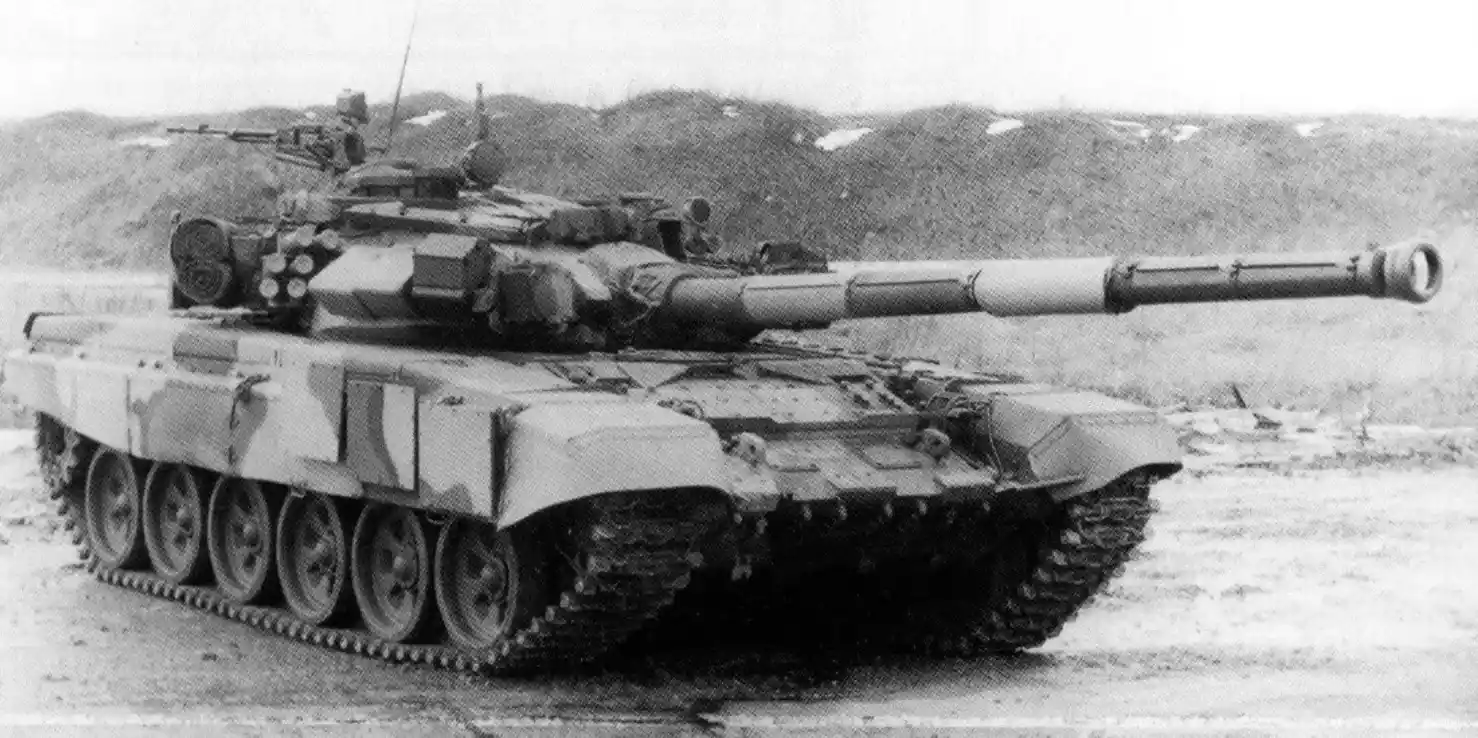
Initially known as the T-72BM, the first four prototypes were delivered for testing in January 1989. A refined version, the T-72BU, followed in June 1990.
By March 1991, the Soviet Ministry of Defense recommended adopting Object 188 for the military. Meanwhile, development on the more advanced Object 187 was abruptly halted for reasons that remain unknown.
Production and service history
In the years leading up to and following the dissolution of the Soviet Union, Russia’s tank production significantly declined. The Kharkiv tank plant, located in what became independent Ukraine, ceased to be part of the Russian production network.
Meanwhile, the Chelyabinsk Tractor Plant halted tank production in 1989, and the Kirov plant in Leningrad followed suit in 1990.
By 1992, state orders for tanks at the remaining facilities in Omsk and Nizhni-Tagil had nearly stopped. Around this period, the Russian Ministry of Defense resolved to focus on producing a single-tank model.
During the 1980s, the Soviet military simultaneously ordered the T-64, T-72, and T-80 from competing design bureaus, despite these tanks having many similar traits.
However, their different components created logistical challenges for the army. While both the T 90 Tank from Nizhni-Tagil and the T-80U from Omsk had strengths, the T-80’s gas turbine engine was notorious for its excessive fuel consumption and unreliable performance.
These flaws became especially apparent during the First Chechen War when the Russian T-80s suffered heavy losses. In contrast, the Russian T-90 Tank, which was not deployed in Chechnya, avoided similar media criticism, even though the T-72, which was used in the conflict, performed poorly.
In January 1996, Colonel General Aleksandr Galkin, head of the Russian Ministry of Defense’s Main Armor Directorate, announced that the Russian military would phase out T-80 production in favor of the Russian T-90 Tank.
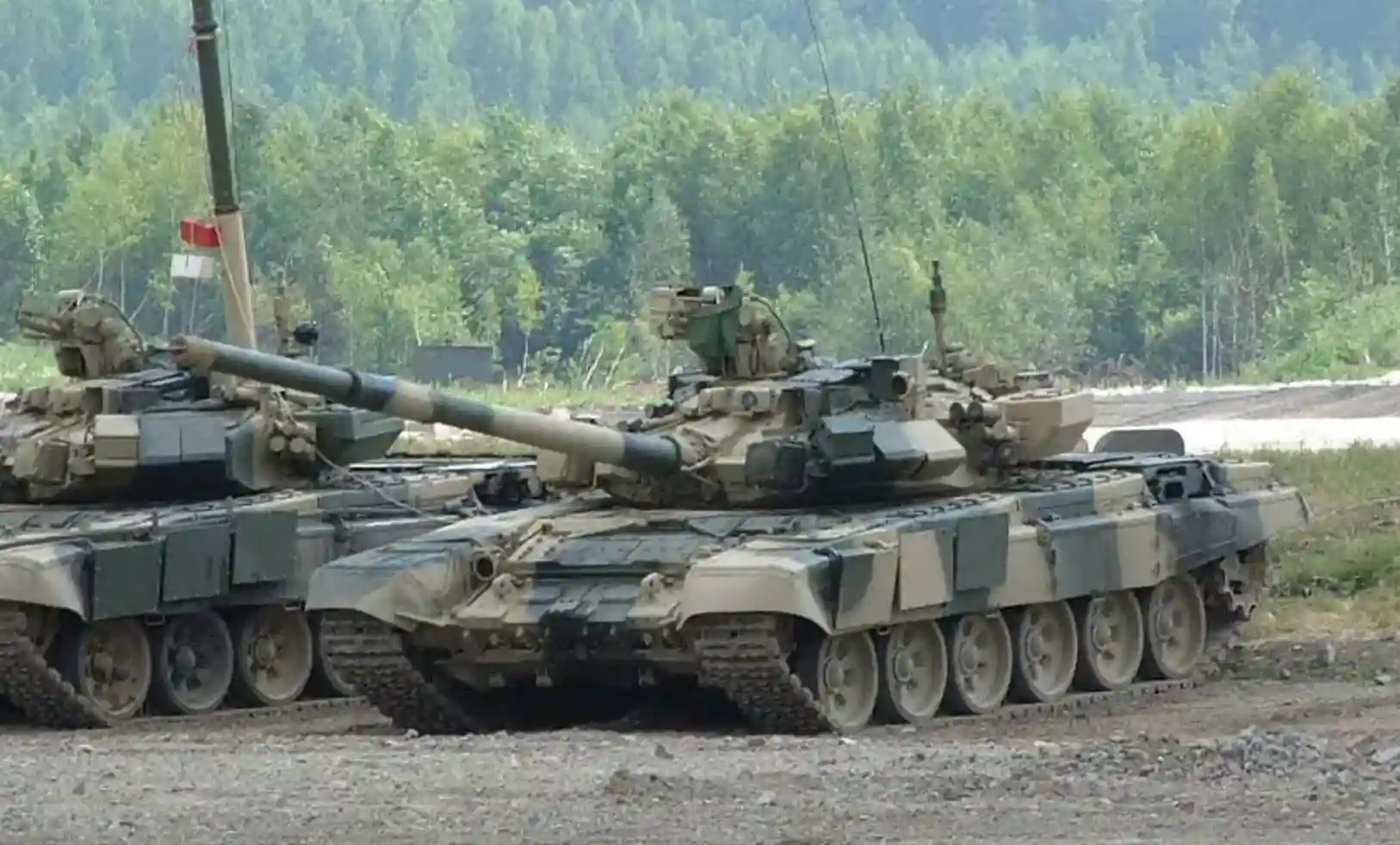
However, later that year, Galkin reversed his stance, calling the T-80U a superior tank. Despite this, Omsk’s T-80 production continued until 2001, mainly for export purposes.
The Russian T-90 Tank’s principal improvement lay in its integration of the T-80U’s advanced 1A45T Irtysh fire control system and an upgraded V-84MS multi-fuel engine producing 840 hp.
Built at the Uralvagonzavod plant in Nizhny Tagil, the Russian T-90 Tank entered low-rate production in 1992, which gradually wound down by the late 1990s for the domestic market. Before a newer version began production in 2004, the Russian Ground Forces had received around 120 T-90s.
By September 1995, approximately 107 T-90s had been manufactured, and many were stationed in the Siberian Military District. A later U.S. report noted that by mid-1998, around 150 T-90s had been produced.
In 1997, India expressed interest in acquiring the T 90 Tank, prompted by Pakistan’s purchase of 320 Ukrainian T-80UDs. By 2002, an additional 82 tanks were delivered, featuring newly welded turrets and the more powerful V-92S2 engine producing 1,000 hp.
Under the initial contract, 186 tanks were to be assembled in India using Russian-supplied kits, with domestic production gradually taking over. However, production delays led India to order 127 additional complete tanks from Uralvagonzavod.
The Russian Army resumed T 90 Tank orders in 2005, requesting a version with the original cast turret. However, with the limited order of just 14 tanks and the high cost of cast turret production, a new configuration similar to the Indian T-90S was quickly accepted into service as the T-90A.
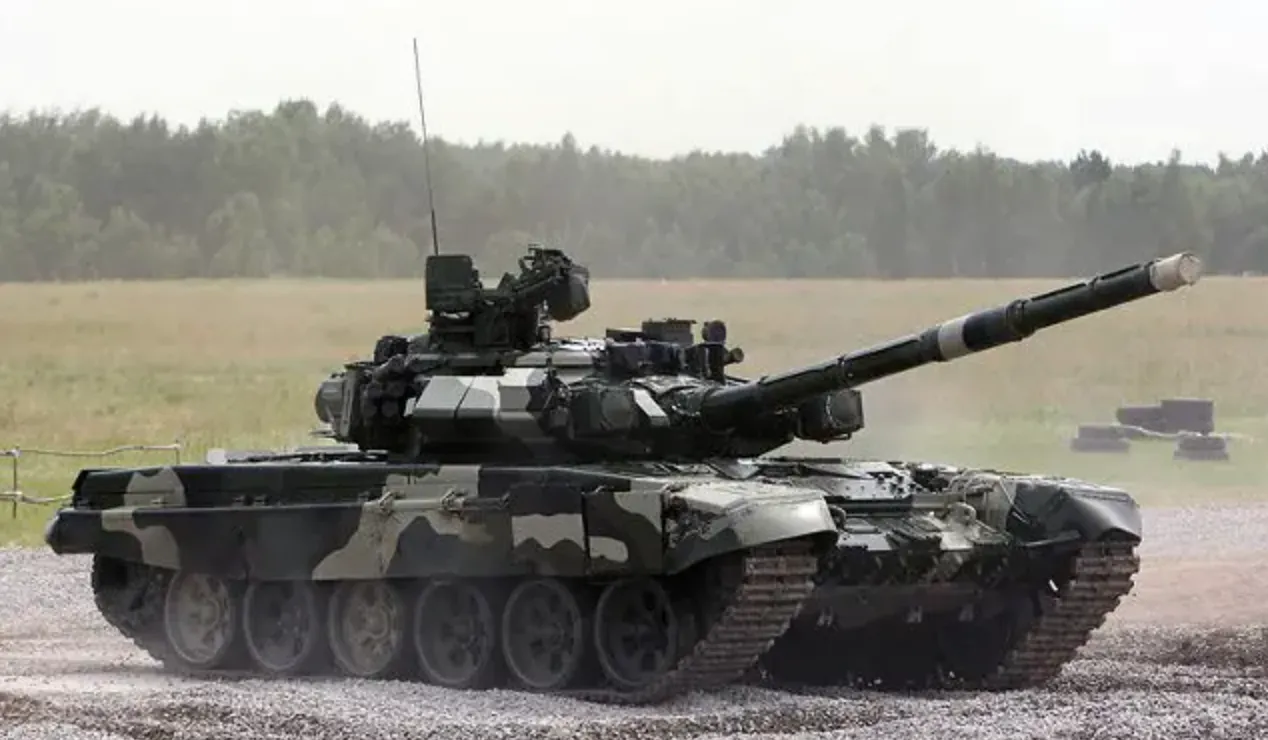
In 2005, Russia received 18 new T-90A tanks, equipped with the V-92S2 engine, the Buran-M gunner’s sight with night-vision capabilities, and the latest Kontakt-5 reactive armor. Over the following years, deliveries continued, with further improvements such as the ESSA gunner’s sight and upgraded ERA tiles.
In the 2000s, the joint venture between Russia’s JSC Volzhsky Optical and Mechanical Plant and France’s Thales Optronics led to the production of Catherine-FC thermal imaging devices, which enhanced the sights of Russian armored vehicles.
By 2012, Russia had advanced to producing third-generation thermal cameras, which improved night-target identification capabilities. In 2016, the Krasnogorsk plant introduced the Irbis-K thermal sight for the T-80U and T-90, significantly enhancing the target identification range compared to Western counterparts.
By 2007, around 334 Russian T-90 Tanks were in service with the Russian Ground Forces, primarily with the 5th Guards Tank Division in the Siberian Military District. Since 2008, the Russian Army received 62 tanks annually until orders were suspended in 2011.
Following the cancellation of the T-95 project in 2010, Uralvagonzavod began developing Object 148, which later became the T-14 Armata, scheduled for serial production in 2022.
In April 2020, upgraded T-90M tanks began being delivered to the Russian Ground Forces’ Western Military District. The T-90M ‘Proryv’ featured a new turret, the 2A46M-5 gun, and a more powerful engine.
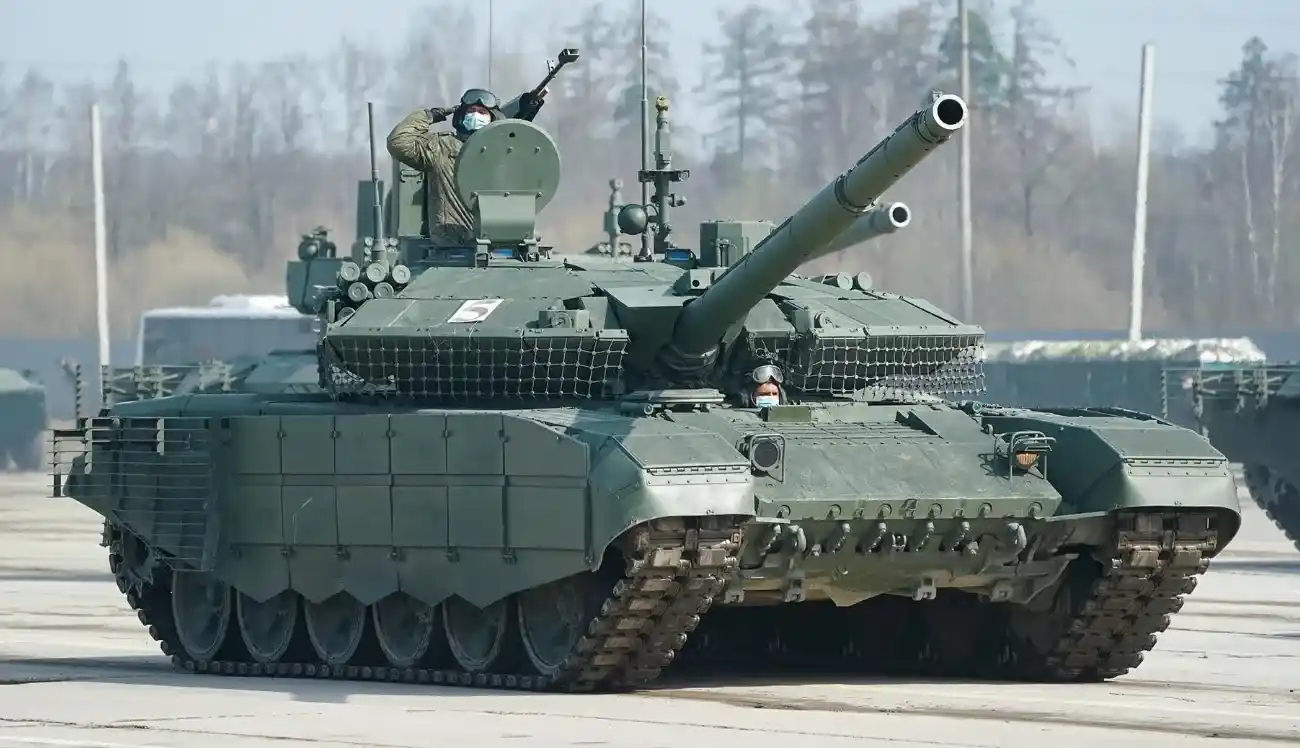
Equipped with a multi-channel sighting system and real-time data-sharing capabilities, the Proryv represented a significant advancement in Russian tank design. A new batch was delivered in March 2021, though production has reportedly slowed due to international sanctions following the invasion of Ukraine.
Despite these challenges, the International Institute for Strategic Studies (IISS) estimated in 2024 that annual T-90M production could reach up to 90 units, though most of these would be upgrades of older models.
Reports indicated that over 200 T-90Ms had been delivered since the start of the Ukraine conflict, with ongoing efforts to increase production, though actual output remained uncertain.
Productions History:
Designer:
- Kartsev-Venediktov
Manufacturer:
- Uralvagonzavod, Heavy Vehicles Factory
Cost:
- 1999: Approximately USD 2.5 million
- 2011: Ranges from USD 2.77 million to USD 4.25 million, depending on the source
- 2016: T-90SM variant priced at around USD 4.5 million
Production Period:
- 1992 to Present
Total Units Produced:
- Roughly 4,000 units as of 2023 (see Operators for details)
License Production:
- Approximately 1,400 units of the T-90S/SM manufactured in India under license
Exports:
- Over 1,000 units delivered to various countries worldwide
T-90 Tank Design
T-90 Armament
The Russian T-90 Tank’s primary weapon is the 2A46M 125mm smoothbore tank gun, a significantly enhanced version of the Sprut anti-tank gun. This same gun is also utilized by the T-80 series tanks. A key advantage of the 2A46M is that it can be replaced without dismantling the tank’s inner turret.
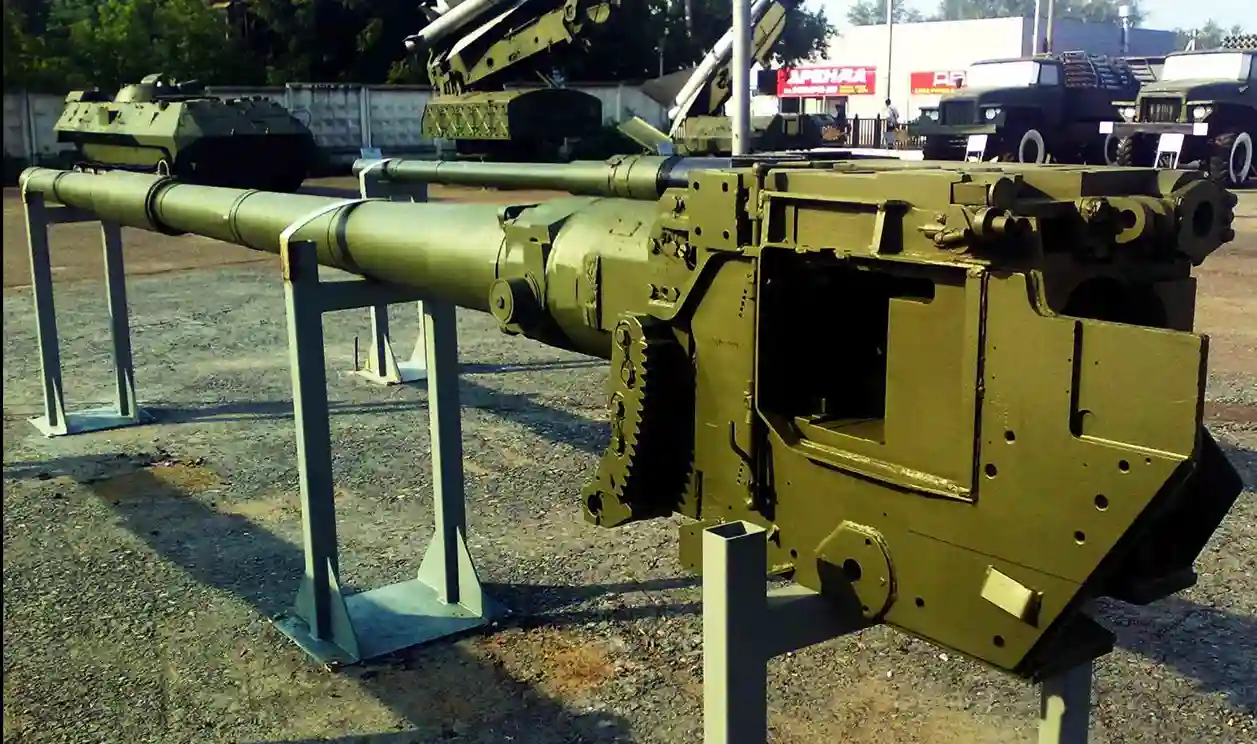
The gun is capable of firing a variety of munitions, including armor-piercing fin-stabilized discarding sabot (APFSDS), high-explosive anti-tank (HEAT-FS), high-explosive fragmentation (HE-FRAG) rounds, and 9M119M Refleks anti-tank guided missiles.
The Refleks missile employs a semi-automatic command-to-line-of-sight (SACLOS) laser-guided system and features a tandem-shaped charge HEAT warhead. It has an impressive effective range of 100 meters to 6 kilometers and takes 17.5 seconds to reach its maximum range.
This missile can penetrate up to 950 millimeters of rolled homogeneous armor (RHA) and is also effective against low-flying air targets, including helicopters.
The Russian T-90 Tank is also equipped with the NSV 12.7mm remotely controlled anti-aircraft machine gun, which is operated by the commander from inside the tank. This heavy machine gun has a range of 2 kilometers and a firing rate of 700–800 rounds per minute, with a supply of 300 rounds.
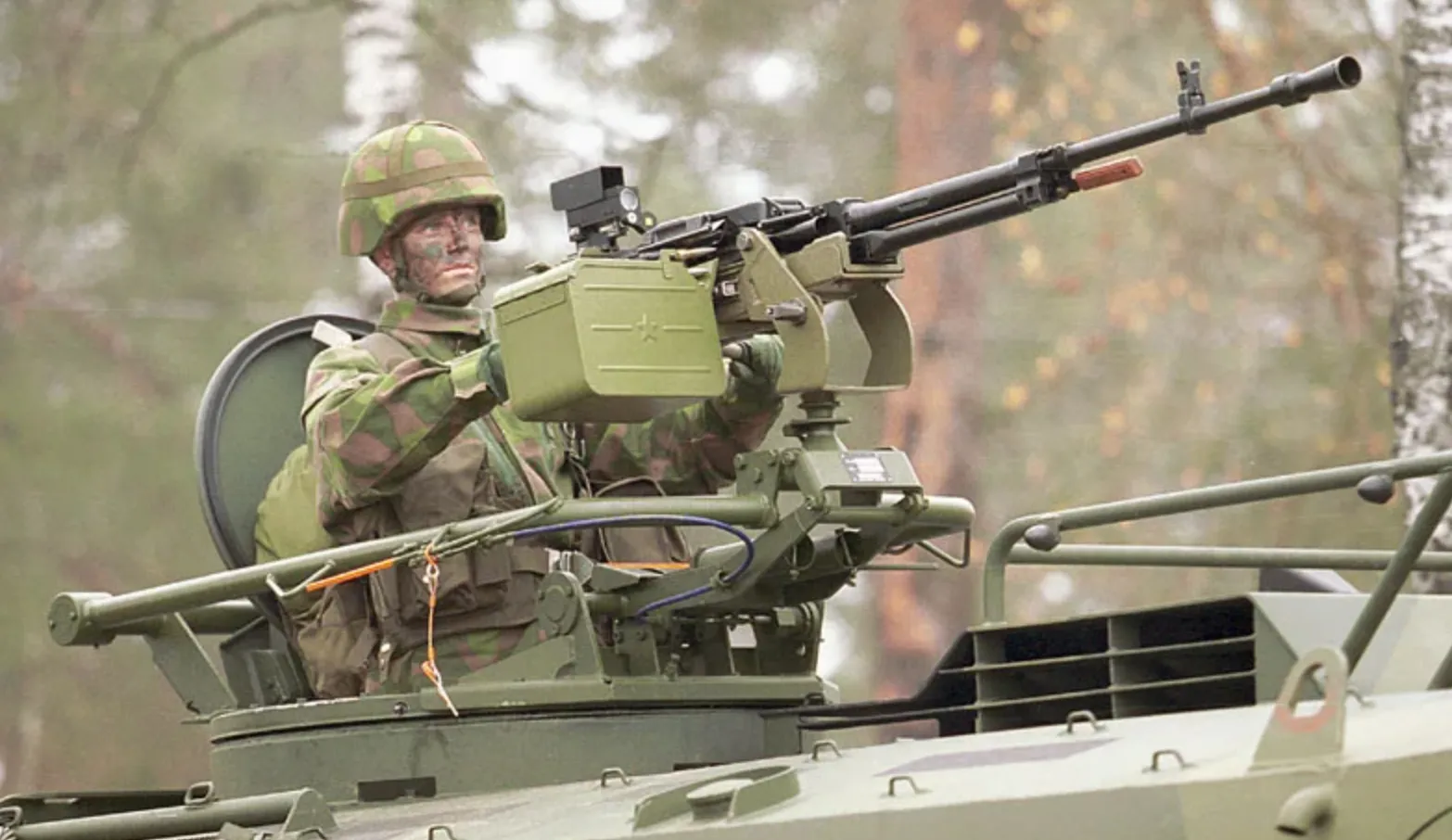
In later models, the NSV was replaced by the Kord heavy machine gun in the late 1990s. The tank is also armed with a PKMT 7.62mm coaxial machine gun, weighing around 10.5 kg, with a 250-round ammunition box, and a total of 2,000 rounds stored.
The 2A46M tank gun is loaded automatically, eliminating the need for a dedicated loader and reducing the Russian T-90 Tank’s crew to three: the commander, gunner, and driver.
The autoloader holds 22 rounds ready to fire and can reload in 5 to 8 seconds. Modern Russian T-90 Tanks are believed to have upgraded autoloaders to accommodate advanced munitions like the 3BM-44M APFSDS, which is comparable to the U.S. M829A3 in terms of armor penetration.
The tank can fire several types of HEAT rounds, including the 3BK21B, which has a depleted uranium liner, the 3BK29 with a penetration capability of 800mm RHA equivalency, and the 3BK29M, featuring a triple-tandem charge warhead.
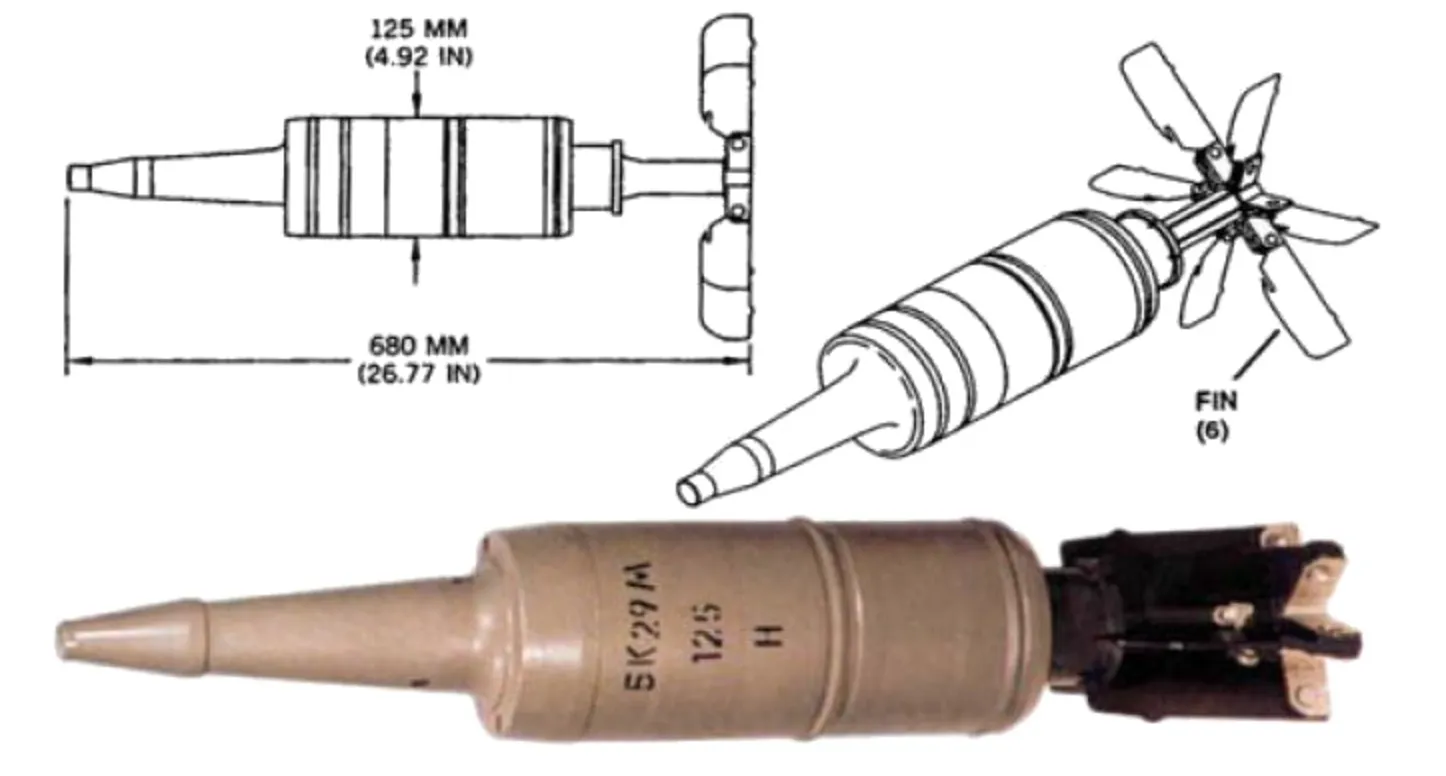
Additionally, the Russian T-90 Tank comes with the Ainet fuse setting system, allowing the gunner to set HE-FRAG rounds to detonate at precise distances, improving effectiveness against helicopters and infantry. The HE-FRAG ammunition can engage targets up to 10 kilometers away, while the APFSDS is effective at 4 kilometers.
The Russian T-90 Tank’s fire-control system demonstrated excellent performance during state trials, with the tank hitting heavily armored targets at ranges of up to 5 kilometers while moving at speeds of up to 30 km/h.
During testing, all 24 missile launches over distances of 4–5 kilometers successfully hit their targets, even when fired by relatively inexperienced operators. In one test, an experienced gunner, while driving at 25 km/h, hit seven armored targets at ranges between 1,500 and 2,500 meters within 54 seconds.
The tank’s fire-control system includes the PNK-4S/SR AGAT day and night sighting system at the commander’s station. This allows night detection of tank-sized targets at ranges of 700 to 1,100 meters, depending on the version of the sight.
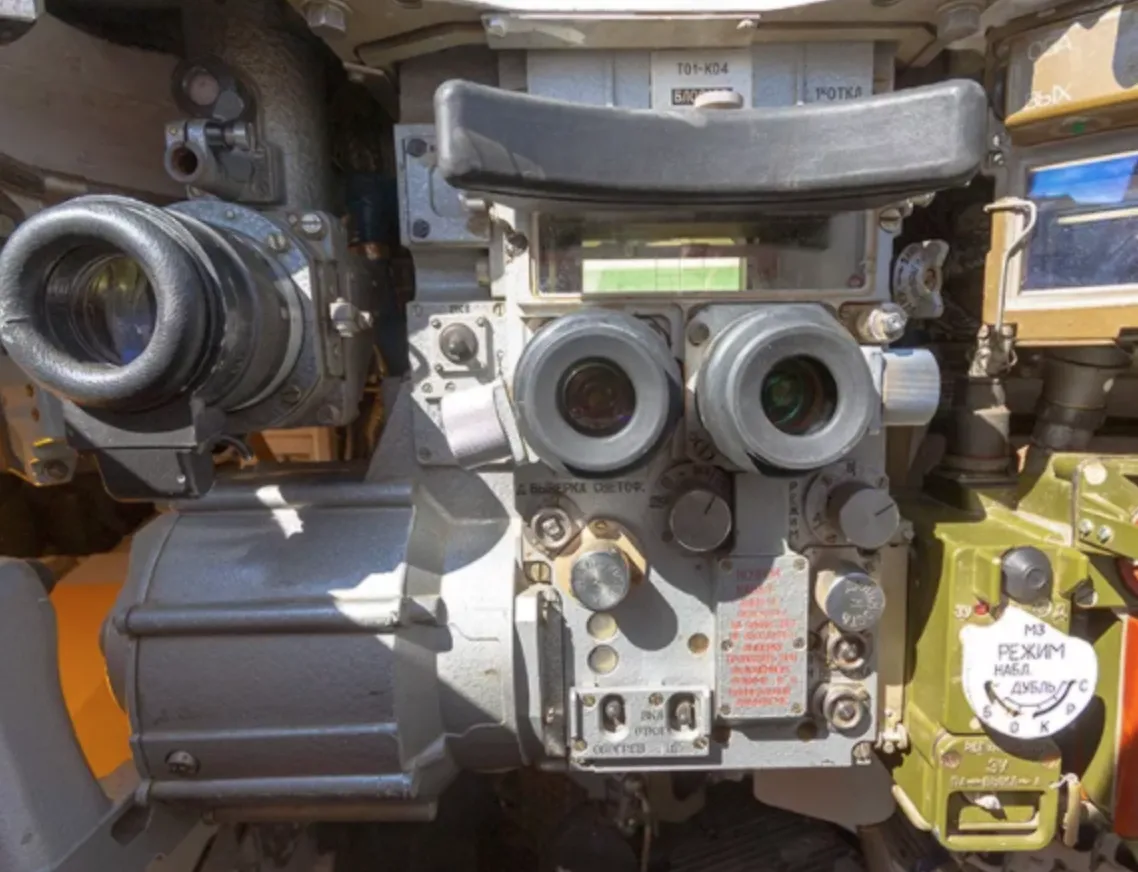
Early Russian T-90 Tank models used the TO1-KO1 BURAN sight, while later models (such as the T-90S) were upgraded to use the ESSA thermal imaging sight. This system enables accurate targeting up to 5,000–8,000 meters during the day and 3,300 meters at night, employing the CATHERINE-FC thermal camera developed by Thales Optronique.
The gunner is equipped with the 1G46 day sighting system, which integrates a laser rangefinder and missile guidance channel, allowing targets at distances of 5 to 8 kilometers to be detected and engaged. The driver uses a TVN-5 day and night sight for improved visibility.
T-90 Engine
The primary engine used in the Russian T-90 Tank series is the V-92S diesel engine, manufactured by the Chelyabinsk Tractor Plant. Various early models of the T-90 tank are equipped with different engines, including the V-84MS, a 618 kW (840 horsepower) four-stroke V-12 piston engine.
Additionally, higher-performance versions of the tank feature engines with 1,000 horsepower (750 kW) and 1,250 horsepower (930 kW), produced by Uralvagonzavod and also supplied by the Chelyabinsk Tractor Plant.
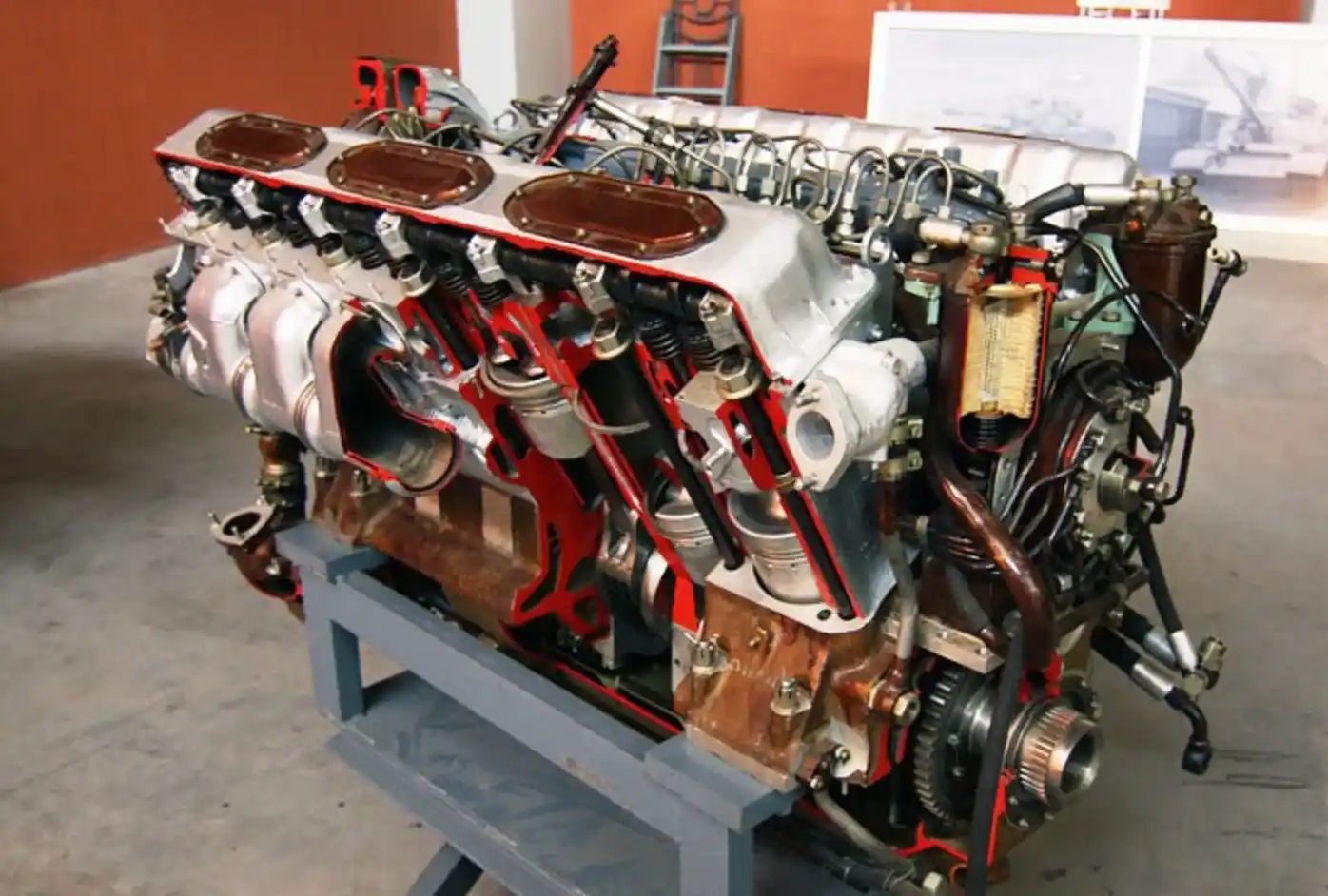
The T-90S model, powered by a 1,000 horsepower (750 kW) engine, can reach a top speed of 60 km/h on paved roads and up to 45 km/h on uneven terrain.
The Russian T-90 Tank follows a conventional design for tanks, with its engine and transmission located at the rear. Its 1,000 horsepower engine is a V-92, a four-stroke, 12-cylinder, multi-fuel diesel engine, while the 1,250 horsepower version features the V-96 engine.
For export purposes, the modified T-90S is equipped with an enhanced multi-fuel diesel engine delivering 1,000 horsepower (750 kW) and featuring turbochargers for increased performance. The tank is also fitted with an air conditioning system, enabling it to operate effectively in hot climates.
T-90 Defense System
The Russian T-90 Tank incorporates a comprehensive three-layered protection system designed to ensure survivability in combat. The first layer is the composite armor on the turret.
This armor consists of a foundational shell with embedded alternating layers of aluminum and plastic, along with a section that deforms in a controlled manner to absorb impact. This innovative combination provides enhanced protection with reduced weight compared to traditional all-steel armor.
The second layer of defense is the third-generation Kontakt-5 explosive reactive armor (ERA). These ERA modules, mounted across the turret, disrupt the effectiveness of armor-piercing fin-stabilized discarding sabot (APFSDS) rounds by significantly degrading their penetration capability.

The distinctive angular design of these modules gives the turret its recognizable “clamshell” shape. Additionally, ERA modules are placed on the turret roof to protect against high-angle attacks.
Along with ERA and steel plating, the frontal armor package of the turret incorporates advanced Russian composite armor layered between steel plates. This composite structure delivers superior protection without the excessive weight of steel.
The third and final layer of protection is the Shtora-1 countermeasures suite, developed by Russia’s Elektromashina. This system includes a range of countermeasures designed to shield the tank from anti-tank-guided missiles (ATGM) and laser-guided weapons.
The Shtora-1 system features two infrared jammers, often referred to as “dazzlers,” mounted on the front of the turret, which produce the tank’s iconic “red eyes.” It also includes four laser warning receivers, two 3D6 smoke grenade launchers, and a computerized control system.
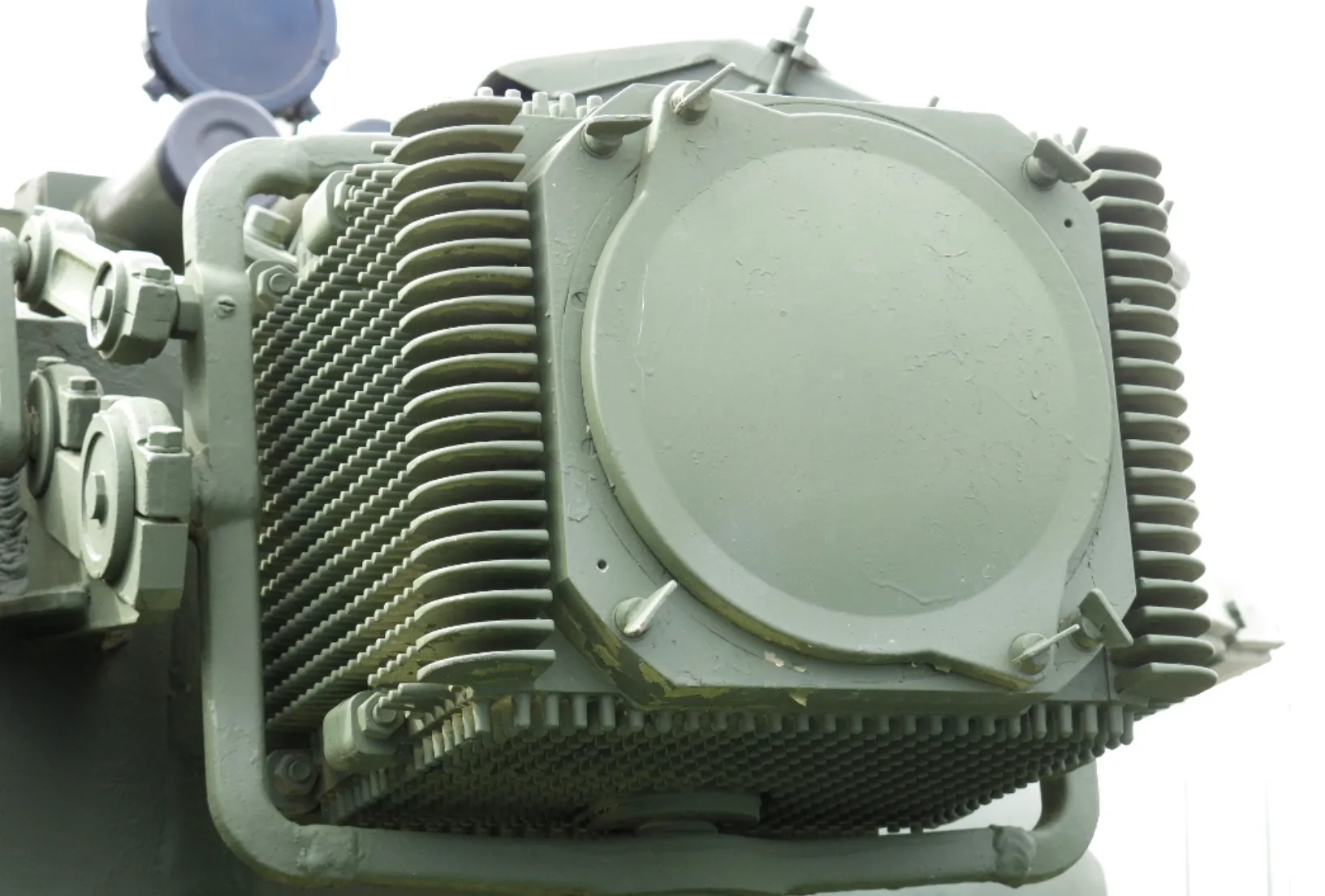
When the tank is targeted by a laser guidance system, Shtora-1 alerts the crew, allowing them to pivot the turret towards the threat. The infrared jammer, known as the TShU1-7, interferes with the semi-automatic command to line of sight (SACLOS) guidance systems, which are used by some ATGMs.
If a threat is detected, the smoke grenades are automatically launched to obscure the tank from laser-guided systems, making it harder for enemy weapons to accurately target it. While Russian T-90 tanks are equipped with the Shtora-1 system, Indian T-90S variants are fitted with the LEDS-150 Land Electronic Defence System instead.
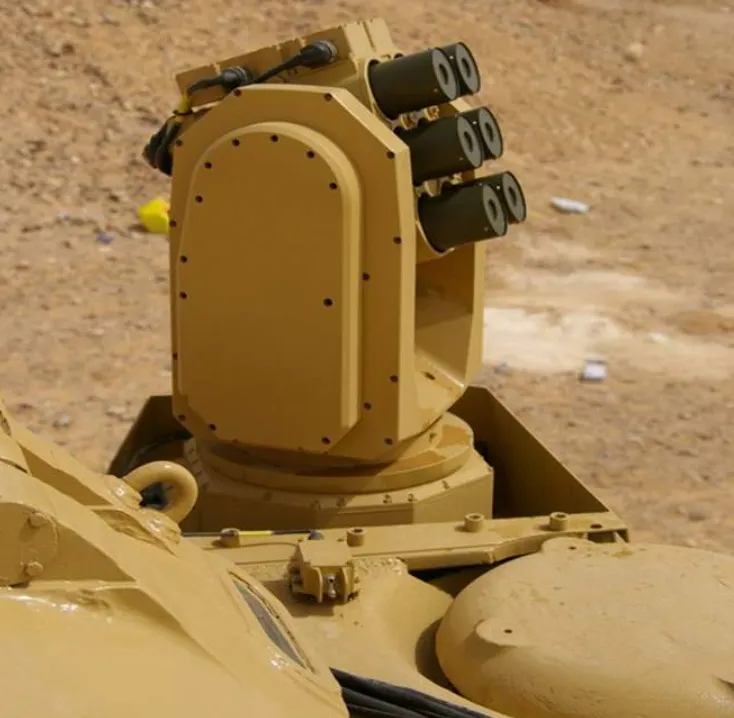
In addition to these passive and active defense systems, the Russian T-90 Tank is equipped with nuclear, biological, and chemical (NBC) protection equipment, KMT mine-clearing devices, and an automatic fire suppression system.
Another option for the Russian T-90 Tank is the EMT-7 electromagnetic counter-mine system, which emits electromagnetic pulses to disable magnetic mines and disrupt enemy electronics before the tank reaches them.
The Nakidka signature reduction system is also available for the Russian T-90 Tank, designed to reduce the tank’s detectability by infrared, thermal, and radar systems.
T-90 Blueprint
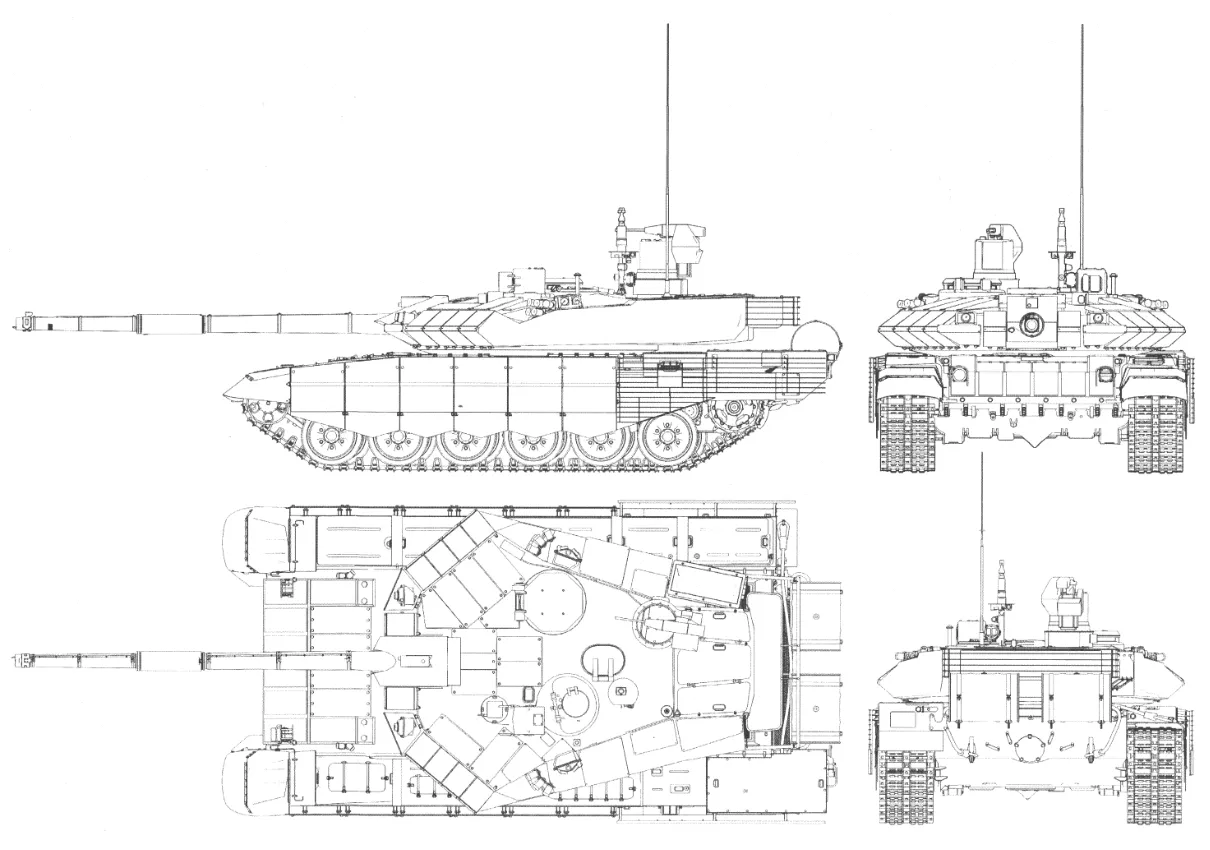
T-90 Tank Variants
T-90 (Object 188)
The original production model of the T-90, known internally as Object 188, was developed in 1989 and entered service in 1992. During its development, it was briefly referred to as the T-72BU. This model weighs approximately 46 tons and serves as the foundational variant in the T 90 Tank series.
T-90K
This variant is a command version of the T 90 Tank, specifically designed to enhance battlefield communication and coordination. It is equipped with the R-163-50K communication station and advanced navigation systems, such as the TNA-4-3, which allows for better command and control capabilities in the field.
T-90A
An upgraded version designed for the Russian military, the T-90A features a welded turret and is powered by the V-92S2 engine. Additionally, it is equipped with the ESSA thermal imaging system. Often referred to as “T-90 Vladimir,” this variant pays homage to its chief designer, Vladimir Potkin. The T-90A boasts improved armor and targeting capabilities compared to earlier models.
T-90AK
This is the command version of the T-90A, mirroring many of the T-90A’s features while including additional communication and navigation equipment to support command roles in the field.
T-90AM (Proryv-2)
The T-90AM, also known by its project name “Proryv-2,” represents a significant upgrade to the T-90A. Introduced in 2011, this variant includes a newly designed turret and weighs around 48 tons. While not yet in active service, the T-90AM features numerous advancements, including enhanced firepower, protection, and mobility, making it a stepping stone toward the more advanced T-90MS.
T-90M (Proryv-3)
This is one of the most advanced iterations of the Russian T-90 Tank series, first unveiled to the public in 2017. The T-90M features a modernized all-welded turret, an advanced Kalina fire control system, and an improved 2A46M-5 main gun paired with a 7.62 mm coaxial machine gun.
The vehicle also has a remote-controlled 12.7 mm “Kord” machine gun, and its armor protection has been significantly upgraded with the Relikt ERA (explosive reactive armor) on both the turret and hull.
Additionally, this version integrates the “soft kill” APS (Active Protection System) Shtora-1 and the “hard kill” APS Arena-M for enhanced survivability. The T-90M includes an upgraded V-92S2F engine with 1130 hp, advanced satellite navigation systems, and a redesigned ammunition storage system that enhances crew safety.
T-90S
The export version of the T-90, this variant was later adopted by the Russian Armed Forces under the designation T-90A. Manufactured by Uralvagonzavod, these tanks are powered by a 1,000 hp engine from the Chelyabinsk Tractor Plant.
They are equipped with the export version of the Shtora-1 protection system, which lacks the infra-red dazzlers of the Russian models but features additional Kontakt-5 reactive armor on the turret. Initially, these tanks were built with cast turrets from the early T-90s, but once supplies ran out, new welded turrets were introduced.
T-90SK
This is the commander’s version of the T-90S, featuring enhanced communication and navigation systems. It includes additional radio and navigation equipment as well as the Ainet remote-detonation system for high-explosive fragmentation (HEF) rounds, making it well-suited for leadership roles on the battlefield.
T-90MS / T-90SM
An export variant of the T-90AM “Proryv-2,” the T-90MS was first showcased at the Abu Dhabi International Defence Exhibition (IDEX) in 2013. It is equipped with a 1,130 hp engine, the Sosna-U gunner sight, a remote weapon station (RWS) with a 7.62 mm machine gun, and an upgraded GLONASS navigation system.
The T-90MS also boasts new Relikt explosive reactive armor that covers a larger portion of the vehicle, providing enhanced protection. Notable features include a removable turret bustle for storing additional rounds, a 360-degree view system provided by four video cameras, and a modernized thermal imager capable of detecting enemy tanks at distances over 3,300 meters.
The same autoloader found in the T-90M “Proryv-3” is used in this variant, further enhancing its combat effectiveness.
T-90 Tank Specifications:
Mass (Weight)
- T-90: 46 tonnes (equivalent to 45 long tons or 51 short tons)
- T-90A: 46.5 tonnes (approximately 45.8 long tons or 51.3 short tons)
- T-90SM: 48 tonnes (equal to 47 long tons or 53 short tons)
Dimensions
- Length:
- Total: 9.63 meters (31 feet 7 inches)
- Hull length: 6.86 meters (22 feet 6 inches)
- Width: 3.78 meters (12 feet 5 inches)
- Height: 2.22 meters (7 feet 3 inches)
Crew Capacity: 3 crew members
Armor Protection
- The Russian T-90 Tank series features a composite armor system made of steel and reactive armor. This armor offers protection against various types of threats, including armor-piercing fin-stabilized discarding sabot (APFSDS) rounds and high-explosive anti-tank (HEAT) rounds.
- APFSDS Protection:
- Standard: 550 mm of protection
- With Kontakt-5 ERA: 800–830 mm of protection
- HEAT Protection:
- Standard: 650–850 mm of protection
- With Kontakt-5 ERA: 1,150–1,550 mm of protection
- APFSDS Protection:
Main Armament
- The Russian T-90 Tank series is equipped with a smoothbore gun, which varies slightly depending on the model:
- T-90: 2A46M 125 mm smoothbore gun with a capacity of 43 rounds
- T-90A: 2A46M-2 125 mm smoothbore gun with 42 rounds
- T-90M: 2A46M-5 125 mm smoothbore gun with 43 rounds
Secondary Armament
- Machine Guns:
- 12.7 mm Kord heavy machine gun for anti-aircraft and light armored targets
- 7.62 mm PKMT coaxial machine gun for engaging infantry and lightly armored vehicles
Engine Specifications
- T-90: Powered by a V-84MS 12-cylinder diesel engine producing 840 horsepower (617 kW)
- T-90A: Equipped with a V-92S2 12-cylinder diesel engine generating 1,000 horsepower (736 kW)
- T-90M/T-90MS: Upgraded to the V-92S2F 12-cylinder diesel engine delivering 1,130 horsepower (831 kW)
Power-to-Weight Ratio
- T-90: 18.2 horsepower per tonne (13.3 kW/tonne)
- T-90A: 21.5 horsepower per tonne (15 kW/tonne)
Suspension System
- The Russian T-90 Tank series uses a torsion bar suspension system, providing good mobility over rough terrain.
Operational Range
- The Russian T-90 Tank can travel up to 550 kilometers (340 miles) on a full tank without the use of external fuel drums.
Maximum Speed
- T-90A and T-90MS: Capable of reaching a top speed of 60 km/h (37 mph) on roads.
Share
Defense Feeds
Defense Feeds is publication focusing on informing, engaging, and empowering the world by providing accurate information from defense technology.
Powered by Defense Feeds © 2025 – All rights reserved.


